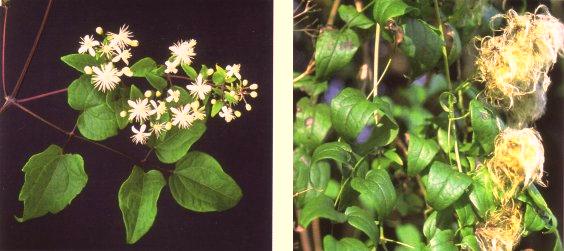|
 An
Illustrated Guide to An
Illustrated Guide to
Common Weeds
of New Zealand
Clematis
vitalba
old
man's beard
Family
RANUNCULACEAE
Reproduced from
Common
Weeds of New Zealand
by Ian Popay, Paul Champion & Trevor James
ISBN 0 473 09760 5
by kind permission of the
New
Zealand Plant Protection Society
Publication or other use of images or descriptive
text on these pages is unauthorised unless written permission is
obtained from the authors and publisher.
Appropriate acknowledgement
of the publication Common Weeds of New Zealand must always
be given.
Available from Nationwide Book Distributors
Tall, clambering,
deciduous, woody perennial climber, growing 20 m or more tall on
trees. Attractive, creamy-white flowers in summer, followed by seeds
with long, fluffy hairs. The leaves, failing in autumn and regrowing
in spring, are in opposite pairs, and each is divided into usually
five widely-spaced leaflets.
- Flowers Creamy-white,
2-3 cm in diameter, fragrant. The four or five, sharply bent back,
petal-like sepals are softly-hairy. The numerous, cream-coloured
stamens are conspicuous. The flowers are in loosely branched,
flat- or convex-topped inflorescences in the leaf axils. Flowers
Dec-May.
- Fruit Grey,
hairy, white-plumed seeds (achenes) 2-2.5 mm long, in dense fluffy
clusters persisting through winter, giving rise to the common
name. Seeds spread by wind.
- Leaves The
leaves, falling in autumn, are thin, papery, softly-hairy, bluntly-toothed,
growing in opposite pairs. Each leaf is divided into five heart-
to lance-shaped leaflets.
- Stems Very
long, woody, six-angled, strongly-ribbed, with light-coloured
bark that easily rubs off. Stems root wherever they touch ground
to make new plants. New growth is green-mauve.
- Roots Fibrous.
Habitat
Second-growth forest,
forest margins, hedges and trees.
Distribution
Widespread and common
throughout NI, and in SI except for Westland and Fiordland. Also
found on Stewart and Chatham Islands. Originally from Europe and
south-western Asia.
Comments
Has become a very serious
problem in some areas in bush remnants and reserves. Has the ability
to smother and eventually bring down large trees. The species
has spread widely since the 1940s. Control is difficult and labour-intensive.
Biological control is being attempted, but its effectiveness cannot
yet be evaluated. Listed on the National
Pest Plant Accord (see Introduction for details). The occasional
death of cattle from eating this plant has been recorded in England.
Related
species
Clematis flammula
is another adventive deciduous clematis, but with thicker, bipinnate
leaves and white flowers, in hedgerows and scrub in northern NI,
Nelson and Canterbury. The native clematis species are all evergreen
with three leaflets (except for the leafless Clematis afoliata).
Derivation
of botanical name
Clematis Gr.
name for a climbing plant; vitalba (Lat.) = white vine.
Web-notes:
Weed Links
On this site
Reproduced from Common Weeds
of New Zealand:
External Links
 Weedbusters
New Zealand Weedbusters
New Zealand
- Weedbusters is a weeds awareness and education programme that aims to
protect New Zealand's environment from the increasing weed problem.
- AgPest
- A free tool to assist farmers and agricultural professionals in decision-making regarding weed and pest identification, biology, impact and management.
 New Zealand Weeds Key New Zealand Weeds Key
- An interactive identification key to the weeds of New Zealand. Developed at Landcare Research.
New
Zealand Plant Conservation Network naturalised plants
- Search for information on more than 2500 naturalised and weedy plants.
 New
Zealand Plant Protection Society New
Zealand Plant Protection Society
- Their main objective: "To pool and exchange information on the biology
of weeds, invertebrate and vertebrate pests, pathogens and beneficial organisms
and methods for modifying their effects."
-
 Massey
University Weeds Database Massey
University Weeds Database- A site providing information about New Zealand weeds and weed control.
It has a series of pages showing pictures of New Zealand weeds, notes on
identification and control. It also provides information on a university
paper entitled Controlling Weeds.
-
-
More
Plant Profiles
|







